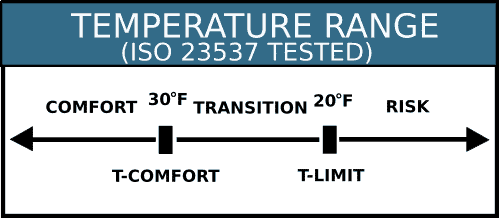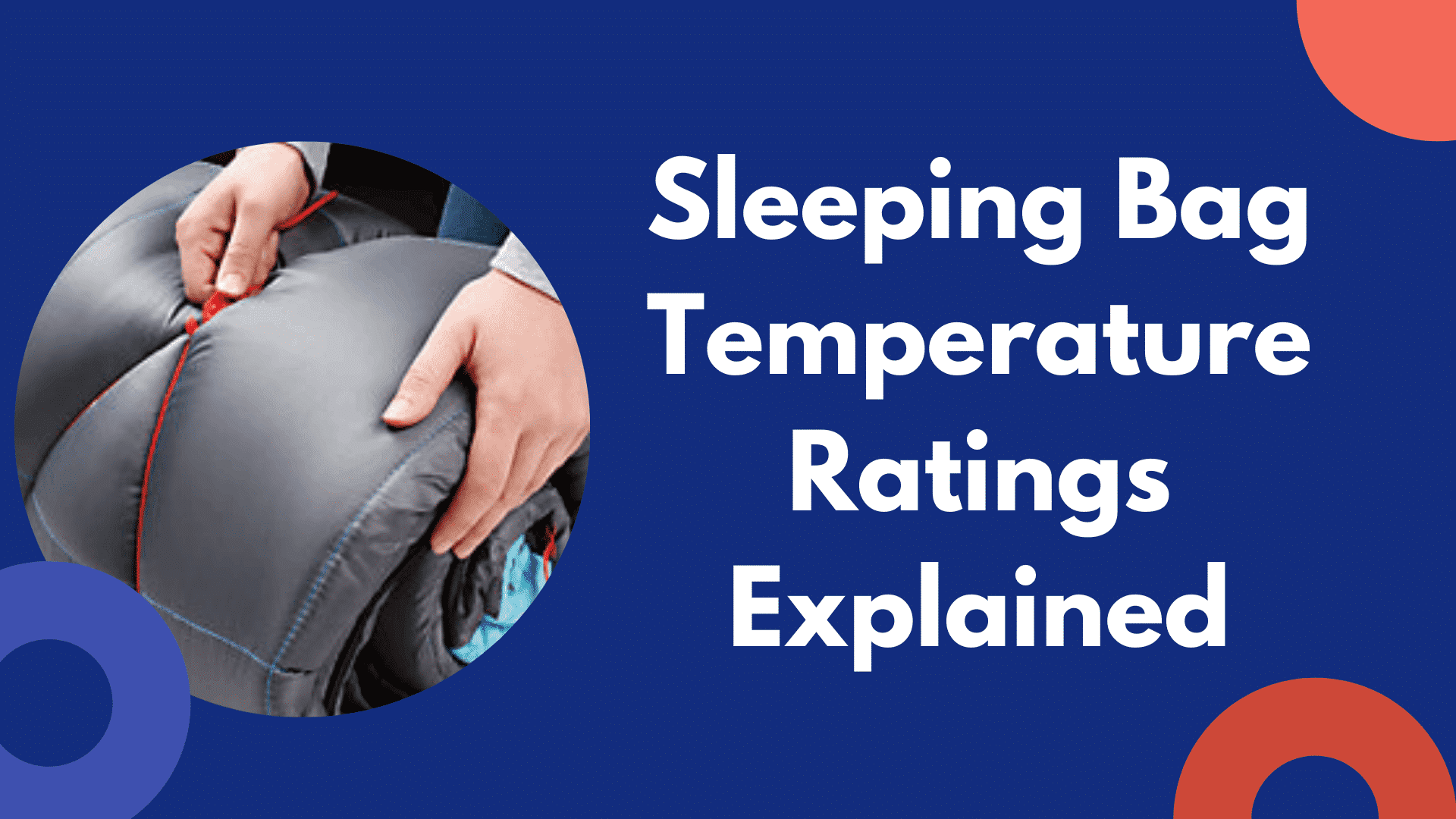Waking up in the middle of the night shivering isn’t fun for anybody. Sleeping in the cold can be a downright miserable experience. With a basic knowledge of temperature ratings, you should never have to suffer through a cold winter night.
If you can figure out the coldest winter conditions you could possibly face, you can find a bag that will keep you warm(at or below that temperature). Finding a sleeping bag doesn’t have to be complicated. With a basic understanding of temperature ratings, you’ll be well on your way to purchasing a new sleeping bag.
Table Of Contents
How to Choose a Sleeping Bags Temperature Rating
Manufacturers tend to be very generous about their temperature ratings. There’s no guarantee you will be comfortable at a given temperature rating.It’s not uncommon for two people to have significantly different minimum/maximum comfort ratings(it can vary by more than 20 degrees).
Even if you don’t factor in different environmental factors like clothing, dinner eaten, sleeping pads, body size and fitness level, everybody’s perception of comfort varies wildly.
Reading Temperature Ratings

It really isn’t all that difficult to read the ISO temperature chart once you understand what the three areas represent. The chart is broken down into three areas, comfort, transition and risk.
- Comfort: This is the area where everybody should be comfortable regardless of sleep preferences. The comfort level in the chart above would be any temperature greater than 30 degrees Fahrenheit. Comfort level is the rating system used on women’s sleeping bags and what’s recommended for cold sleepers.
- Transition-Lower Limit: The transition area is the zone where some people will start to feel cold, but there’s no risk of serious exposure to the cold. In the example above the transition area goes from 20-30 degrees with a lower limit of 20 degrees. The lower limit rating is the manufacturer spec found on men’s sleeping bags.
- Risk: The risk zone is where everybody will be cold and you risk serious bodily harm. Only use a bag in the risk zone in extreme emergencies.
Don’t Trust Temperature Ratings
You should never trust a manufacturers temperature rating. They should only be used as a guide to narrow down your choice. If you’re a cold sleeper(love to pile on blankets), go with a temperature rating 15-20 degrees lower than your expected needs. If you sleep warm at night, you might be able to stick to the manufacturer’s guidelines.
Sleeping Bag Liners Give You Room to Work
Sleeping bag liners give you that little bit of wiggle room to guarantee a comfortable night’s sleep. Bag liners protect your sleeping bag from dirt/debris, sweat and significantly improve your bags temperature rating.
Bag liners range from only adding a couple of degrees to raising your rating by 30 degrees. With the right bag liner, you can turn a cheap 3-Season bag into a cold-weather bag and they really aren’t all that expensive.
Check out this cheap Coleman sleeping bag liner for instance. It will increase your bags temperature rating by 12 degrees while preventing additional drafts. Or you could go with one of Sea to Summits bag liners that adds 25 degrees of warmth to your bag(this is what I use). Sometimes I’ll ditch my bag during the summer and only use the bag liner.
How Do Manufacturers Test Temperature Ratings?

Thankfully, the days of manufacturers creating their own temperature ratings is behind us. In the old days, manufacturers would figure out temperature ratings in private labs, which allowed them to grossly overestimate temperature ratings.
Back then, temperature ratings were wild and dangerous. You couldn’t test out a bag without purchasing it and seeing what happens(which obviously didn’t work). Luckily, the outdoor industry solved the problem by creating a uniform testing system.
Now all of a sudden the industry was testing bags by using the same standards. Nowadays brands send their sleeping bags off to labs for independent testing.
Follow ISO Standards
Most manufacturers test out their gear by sending them in to be tested by the International Standards Organization. By following the ISO guidelines you know exactly what temperature rating you’re getting. You can compare temperature ratings between manufacturers regardless of origin.
Unlike old temperature ratings which only gave a single temperature the ISO system gives a temperature range that’s comfortable for most people. They give you a comfortable range, minimum temperature, and danger range. It gives you a wide comfort range, due to the very subjective nature of comfort.
- Comfort Range(aka Comfort Rating): This is the comfort level where the majority of women feel comfortable. According to the ISO this is the point where women can lay in a relaxed posture without feeling cold. Women’s sleeping bags refer to the comfort range when talking about temperature rating.
- Lower Limit Rating: The lower limit rating will always be lower than the comfort rating. This is the standard temperature rating used in men’s sleeping bags and refers to the rating of a warm sleeper.
- Transition Range: The transition range is the point where you start to feel cold. This is the point where your body is curled up actively fighting the cold, but you’re not getting any colder.
- Extreme Range: In the extreme range you’re seriously cold and you’re risking hypothermia. Only use a bag in this range in extreme emergencies.
Just remember that not everybody is comfortable at the same temperature rating. How you feel, your dinner, hydration, perspiration, clothing, bag liners, sleeping pads, etc all have an effect on how warm we sleep. Start including the outside variables and it’s impossible to figure out how warm you’ll actually be.
EN vs ISO (European Norm vs International Standards Organization)
The EN(European Norm) standard was introduced in 2005 to make side by side comparisons between sleeping bags easy. Every sleeping bag from 2005-2017 had to be independently tested and given a comfortable temperature and limit rating.
In 2017 the new ISO standard was introduced updating the testing protocol to include new technologies. Although the testing protocol was updated most of the tests remained the same. Side by side, the EN and ISO rating systems provide very similar results.
Testing Results are Estimates
Even though the EN/ISO standards changed the way we rate sleeping bags, temperature ratings are still estimates. Lab testing is used to simulate the way a sleeping bag will be used in perfect situations(not the way most people sleep).
Labs test sleeping bags in a simulated environment with a sleeping pad under the bag and a test dummy dressed in moderate base layers. It doesn’t take into account body type, sleep position, sleep preferences(warm or cold sleeper), different gear/clothing, changing weather, perspiration, etc.
After doing a little research I came across REI’s explanation of the testing protocol “temperature tests use a full-size mannequin with heaters and temperature sensors dress in one layer of long underwear and a hat. The bag is laid on top of an insulated sleeping pad inside a climate-controlled chamber. The mannequin is heated to simulate body warmth and measurements are taken inside the chamber and on the skin surface of the mannequin. From these measures the insulation value of the mannequin is taken”.
That sounds like the perfect test, but there are currently 5 different testing centers around the world all using different testing gear. They don’t use the same sleeping pad, socks,hat, thermal underwear etc in the testing process. Think of the different R-Values of sleeping pads; they range from R-Values of like .5 all the way up to 6.5+. Even though the lower/upper limits will be similar the results will vary significantly from one facility to the next.
Although the testing procedure ensures every test is performed in a similar manner, real-world results will be different. Most backpackers recommend buying a sleeping bag 15 degrees below your actual needs. It’s much easier to strip off clothes at night than carrying in extra layers.
Women’s Sleeping Bags Use a Different Rating
Due to psychological and physical differences, the average woman will feel colder given the same temperature as a man. Most women are significantly smaller than men, which means they burn fewer calories and put off less body heat.
So a women’s bag always states the comfort rating which is the temperature rating for cold sleepers which is generally the target spec for women. Instead of performing additional testing catered towards women, manufacturers just use the upper comfort rating.
Sleeping Bag Numbers Don’t Match Temperature Ratings
Sleeping bag manufacturers are a tricky bunch. Just because a sleeping bag is named the “Super Sleeper 15”, doesn’t guarantee it’s a 15-degree sleeping bag. It’s common practice to round down to the nearest 5 or 0, which is kind of devious if you think about it.
So a sleeping bag with a 24 degree lower ISO limit will almost always be called a 20 for advertising purposes. Always look at the independent testing before making a purchase.
Women’s Sleeping Bags are Bigger
Side by side a women’s sleeping bag will almost always be puffier than a mans. Since manufacturers advertise off of the comfort rating rather than lower limit, they need to use more filling to bring down the rating.
When purchasing a bag your best bet is to ignore all the advertising hoopla and just check the ISO/EN tag for its upper and lower comfort values. Most of us fall somewhere in the middle.
Cheap Bags Probably Won’t Have ISO/EN Numbers
Most sleeping bag manufacturers are too cheap to get testing done on their budget lineup of bags. They give you a rough estimate of the temperature rating, but that varies wildly from one bag to the next. Whenever you see a temperature rating that doesn’t specificallys say it’s the “comfort” or “lower limit” you know that’s an estimate.
Kids bags and bags designed for casual 3-Season use don’t really need a lower limit and comfort rating. These bags are designed primarily for summer use when bags really aren’t all that necessary to survive.



